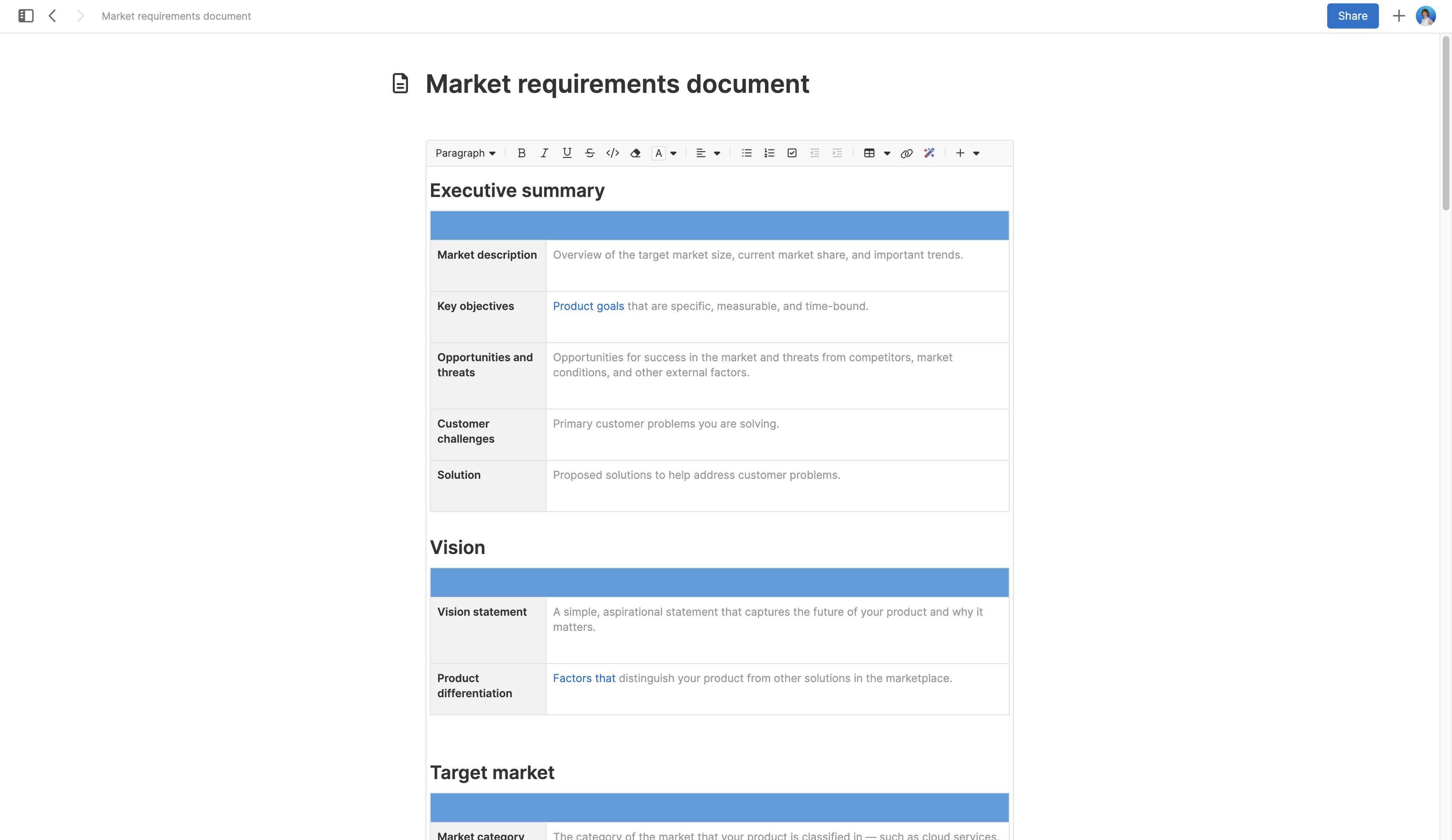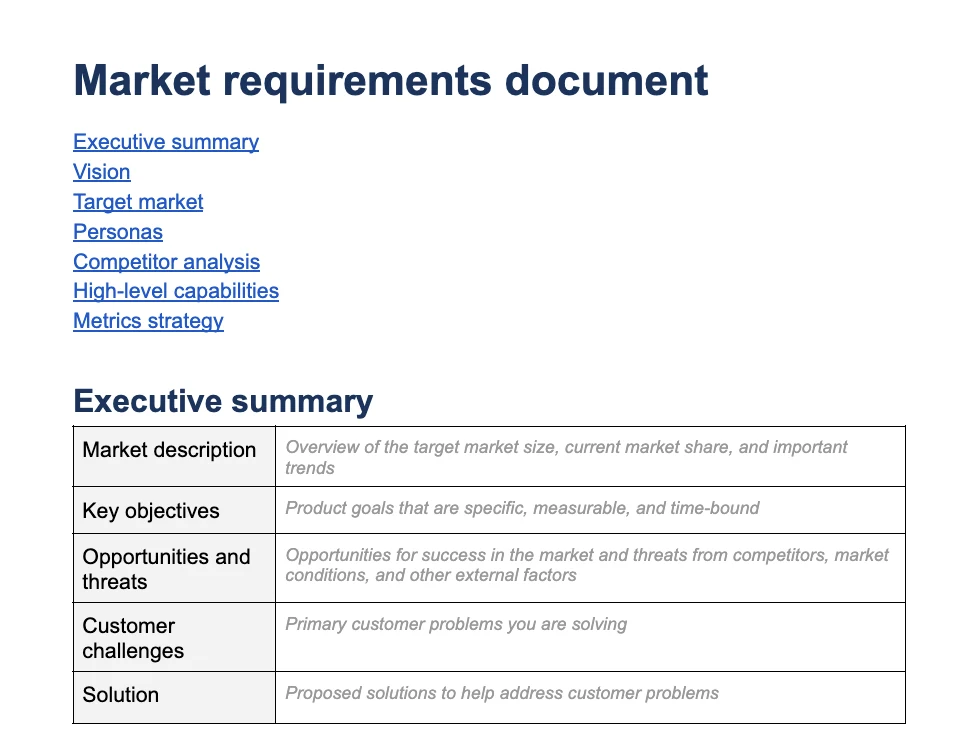Executive summary
The executive summary is a condensed version of the entire document — with top-level objectives, customer challenges, and proposed solutions. It typically includes these sections:
Market description | Overview of the target market size, current market share, and important trends |
Key objectives | Product goals that are specific, measurable, and time-bound |
Opportunities and threats | Opportunities for success in the market and threats from competitors, market conditions, and other external factors |
Customer challenges | Primary customer problems you are solving |
Solution | Proposed solutions to help address customer problems |
Vision
Product vision represents the core essence of your product — where you are headed and why it is important. It sets a clear direction that guides product goals, initiatives, and decisions.
Vision statement | A simple, aspirational statement that captures the future of your product and why it matters |
Product differentiation | Factors that distinguish your product from other solutions in the marketplace |
Target market
The target market section includes industry data and customer details to substantiate the market opportunity. You can use this section to capture information about both existing and potential markets.
Market category | The category of the market that your product is classified in — such as cloud services, e-commerce, and healthcare, among many others |
Market size | The number of potential customers who would benefit from buying your product — often measured as an estimated revenue range. For example, you can calculate market size by multiplying the number of potential customers in your market category by their average annual revenue. |
Market share | Refers to the percentage of sales in the industry earned by your product. Divide your product sales by total sales for the market (via industry data) to determine market share. |
Key customer segments | Potential customer segments that will use your product — segmented by demographics, psychological attributes, geography, or behavior |
Customer challenges | Primary pain points felt by your customers |
Personas | Fictional representations of your customers, including demographic information, goals, challenges, and preferences. See the Personas table below for more information. |
Competitors | Companies that offer similar products or services within the same market. See the Competitor analysis table below. |
Channels | Channels available for communicating with your target market — such as email, website, and referral |
Personas
Customer personas are fictional representations of the real people who interact with your product. Well-defined personas help you empathize with your customers, understand their needs, and build a better product. You can create a unique persona to represent each customer type.
Name | A name that helps define who the persona is |
Description | A high-level description of their job, role, and interests |
Experience | Years of experience in their role or position |
Job responsibilities | Functions, tasks, and competencies as part of their role |
Education | Average level of school years completed |
Product knowledge | Their familiarity with your product — i.e. high, medium, low |
Goals | Personal or professional objectives |
Challenges | External or internal factors that block progress towards their goals |
Likes | Preferences related to products and services that solve their challenges |
Dislikes | Dislikes related to products and services that solve their challenges |
Trusts information from | Sources they receive information from and respect |
Influence | Other people in their organization that they have influence over and share information with |
Competitor analysis
The competitor analysis section outlines other solutions that offer similar products or services to yours. Understanding the other options available to your customers can help you differentiate your product in the marketplace. Complete this section separately for each major competitor.
Organization | Name of competitor |
Mission | Their mission statement or high-level business objective |
Description | A summary of the organization and any distinguishing features (often found on the company's "About us" page) |
Products | Products or services they provide |
Revenue | A rough estimate of company revenue, if available |
Customers | Their target customers and how they differ from your own |
Strengths | Areas in which they excel |
Weaknesses | Areas in which they are lacking (or for which your product excels) |
Differentiators | Factors that make them unique or compelling in the market |
High-level capabilities
This section of the MRD turns to your product's capabilities — how it will help customers solve the problems you have defined. At this point, avoid detailed design and development specifications. This is a high-level summary to help the product team align on what needs to be built.
Jobs to be done | The jobs or tasks that your customers need to complete |
Current challenges | Current challenges faced by customers that your product will solve. If you are completing this section of the MRD for an existing product, you can include current difficulties that customers are experiencing with the product. |
Desired capabilities | Functionality that customers want — based on customer feedback |
Metrics strategy
This final section focuses on performance metrics and is typically tied to your business model. For a new product, you will look at high-level objectives and metrics. For a new feature set, you will zero in on the impacts of the new features.
Revenue | Projected revenue of the product (or impact to revenue of new features) |
Pricing | Product pricing (or new pricing based on added functionality) |
Key objectives and metrics | Desired long-term impact of your product or new feature set — including metrics for success |

